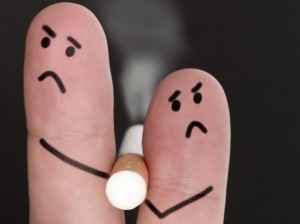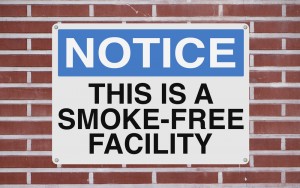By Olivia Maynard @OliviaMaynard17
This blog originally appeared on the Mental Elf site on 18th May 2015.
One in three people with mental health illnesses in the UK smoke, as compared with one in five of the general population. In addition, smokers with mental illnesses smoke more heavily, are more dependent on nicotine and are less likely to be given help to quit smoking. As a result, they are more likely to suffer from smoking-related diseases, and on average die 12-15 years earlier than the general population.
Since July 2008, mental health facilities in England have had indoor smoking bans. However, NICE guidelines recommend that all NHS sites, including psychiatric hospitals become completely smoke-free, a recommendation previously examined by the Mental Elf.
This NICE recommendation has been criticised by those who argue that:
- Tobacco provides necessary self-medication for the mentally ill;
- Smoking cessation interferes with recovery from mental illness;
- Smoking cessation is the lowest priority for those with mental illnesses;
- People with mental illnesses are not interested in quitting;
- People with mental illness cannot quit smoking.

Judith Prochaska, a researcher at Stanford University, has previously addressed each of these arguments (she calls them ‘myths’) (Prochaska, 2011). The abridged summary of the evidence surrounding myths 1, 2 and 3 is that:
- Smoking actually worsens mental health outcomes; in fact, the argument that nicotine provides self-medication is one which has been promoted by the tobacco industry itself;
- Smoking cessation does not exacerbate mental health outcomes;
- Smoking cessation should be a high priority, given that mental health patients are much more likely to die from tobacco-related disease than mental illness.
These are interesting and important arguments and more evidence surrounding them is also available here (Prochaska, 2010).
However, in this blog post I focus on ‘myths’ 4 and 5, drawing on a recent systematic review investigating the impact of a smoke-free psychiatric hospitalisation on patients’ motivations to quit (myth 4) and smoking behavior (myth 5) (Stockings et al., 2014).

Methods and results
Stockings and colleagues searched for studies examining changes in patients’ smoking-related behaviours, motivation and beliefs either during or following an admission to an adult inpatient psychiatric facility.
Study characteristics
Fourteen studies matched these inclusion criteria, two of which were conducted in the UK. The majority of the studies used a cross-sectional design and none were randomised controlled trials. The studies were all quite different, with the number of participants ranging from 15-467 and the length of admission ranging from 1-990 days. Crucially, the type of smoking ban varied considerably between the studies, so I’ll consider these separately.
Facilities with complete smoking bans
Six studies were conducted in facilities with complete bans. All of these offered nicotine dependence treatment, including nicotine replacement therapy (NRT) or brief advice.
- Only one of these statistically assessed smoking behaviour, finding that cigarette consumption was lower during admission compared with prior to admission.
- Three studies assessed smoking behaviour after discharge, finding that the majority of patients resumed smoking within five days. However, there was some evidence from the two larger studies that smoking prevalence was still lower at two weeks and three months post-discharge compared with prior to admission.
- The one study to statistically assess smoking-related beliefs and motivations found that patients expected to be more successful at quitting following discharge compared with at admission. Higher doses of NRT were related to higher expectations of success.
Facilities with incomplete bans
Eight studies were conducted in facilities with incomplete bans.
- Four banned smoking indoors and all of these offered nicotine dependence treatment:
- Only one of these statistically assessed smoking behaviour, finding that quit attempts increased from 2.2% when smoking was permitted in specific rooms, to 18.4% after the ban.
- One study that assessed smoking prevalence post-discharge found that all participants (n = 15) resumed smoking.
- One study found that participants expected to be more successful in smoking cessation post-discharge as compared with at admission.
- Three allowed smoking in designated rooms, with no nicotine dependence treatment:
- There were mixed results among the two studies which assessed smoking prevalence during admission.
- Compared with at admission, there was some evidence of increased motivation to quit smoking.
- One restricted smoking to five pre-determined intervals per day, with no nicotine dependence treatment:
- Motivation to quit was lower at discharge compared with at admission.

Conclusions
The authors concluded that:
Smoke-free psychiatric hospitalisation may have the potential to impact positively on patients’ smoking behaviours and on smoking-related motivation and beliefs.
Strengths and limitations
The fourteen studies included in this review were all quite different from each other and had a number of limitations including:
- Small sample sizes;
- Incomplete reporting of key outcomes;
- Failure to use controlled, experimental research designs;
- Differences in the types of smoking bans in place;
- Inconsistent provision of nicotine dependence treatment.
These key differences and limitations prevented statistical examination of the results as a whole. This means that making firm conclusions is difficult. There is clearly a need for more research in this area.

Summary
There is evidence that people with mental illnesses are interested in quitting smoking (myth 4) and that they are able to (myth 5). However, we still need more studies to examine these questions with well-powered (i.e. large sample sizes), high-quality (i.e., experimental) research designs.
The evidence presented in this systematic review suggests that complete bans are the most effective at encouraging smoking cessation and that the provision of nicotine dependence treatment, such as NRT or brief advice, is also crucial.
Although a handful of the studies assessed smoking behaviour after discharge, none of the facilities viewed this as an important outcome. Given the high level of smoking-related disease among those with mental health illnesses, ensuring that individuals remain abstinent from smoking after discharge is important for the continuing good health of these individuals.
Importantly, none of the studies in this review explored the impact of smoke-free legislation on mental health outcomes. Although the evidence suggests that smoking cessation actually improves mental health outcomes, future research should continue to examine this relationship.
Over to you
Do you have a mental health illness yourself, or support someone who does? Do you work with people with mental health illnesses? Should psychiatric hospitals become smoke-free?

Links
Primary paper
Stockings EA. et al (2014) The impact of a smoke-free psychiatric hospitalization on patient smoking outcomes: a systematic review. Aust NZ J Psychiatry 2014 May 12;48(7):617-633. [PubMed abstract]
Other references
Prochaska, J. J. (2010). Failure to treat tobacco use in mental health and addiction treatment settings: A form of harm reduction? Drug and Alcohol Dependence, 110(3), 177-182. doi: http://dx.doi.org/10.1016/j.drugalcdep.2010.03.002
Prochaska, J. J. (2011). Smoking and Mental Illness — Breaking the Link. New England Journal of Medicine, 365(3), 196-198. doi: doi:10.1056/NEJMp1105248
